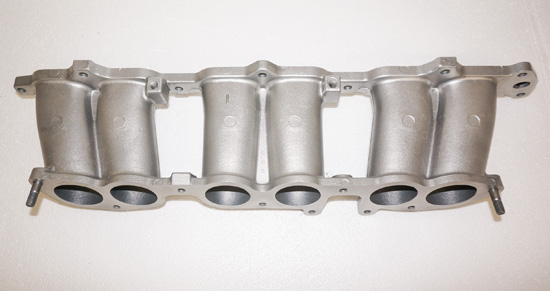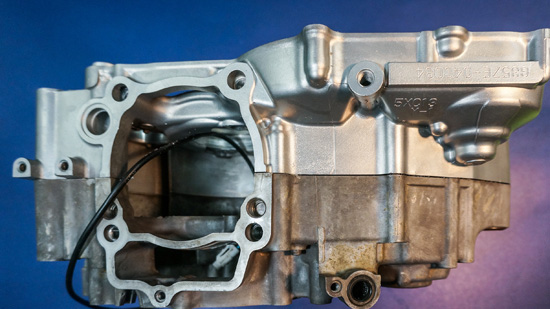Vapor Blasting
Vapor blasting is the optimal surface-finishing process for safe and effective cleaning, restoration and protection of engine, drivetrain and chassis components or any component where the highest quality of surface restoration is desired.
Also known as wet blasting, vapor honing, or liquid honing, the vapor blasting process was developed by the British during WWII. It uses a slurry of water, abrasives and detergents pressurized by compressed air to gently degrease and clean while sealing the surface. Although vapor blasting does clean, its primary purpose is that of a finishing process that produces an attractive soft “satin-like” finish that looks terrific and helps resist staining and oxidation. The finish is produced through a rapid flow of waterborne abrasive, resulting in a softer and more luxurious finish than either soda or bead blasting due to the cushioning effect of the water. Vapor blasting works well on mild steels, stainless steels, aluminum, brass and bronze metals. The appearance of the final finish will vary depending on the alloy; however, it is especially suited to aluminum alloys.

Before & After

Unlike dry blasting, vapor blasting impregnates no media into the component. With vapor blasting, the ricochet angle of the media is reduced compared to dry blasting due to the cushioning effect of the water. The reduced angle of the media combined with the constantly changing angle of the media produces an even lapping effect across the component’s surface, resulting in a soft micro-like finish. Additionally, vapor blasting preserves important identification marks and traits, and can help detect imperfections and damaged areas.
A Vapor blaster consists of a large cabinet with windows along with a sump located at the bottom of the cabinet. A glandless polyurethane pump agitates water and media into a slurry within the sump area. Through associated hoses within the cabinet, the pump delivers the slurry to a manually controlled handheld nozzle. The slurry is pumped at approximately 30 psi to the nozzle while compressed air is also injected at the nozzle to further accelerate the slurry, providing the cushioned cleaning effect that produces the distinctive soft “satin-like” finish.
Vapor Blasting Benefits
- Safely, effectively and simultaneously degreases, cleans and restores
- Enhances the aesthetics and beauty of a component
- Does not impregnate media into a component
- Preserves important identification marks and traits
- Can help detect imperfections and damaged areas
Vapor Blasting Applications
- Degreasing, cleaning and surface finishing
- Prepping metal surfaces for specialty coatings, plating or machining operations
- Restoring a component to its original state
- Enhancing the aesthetics and beauty of a component
- Helping detect imperfections and damaged area
Vapor Blasting FAQs
1) What types of metal does Advanced Tec-Neeks Super-Finishing (ATSF) vapor blast?
We vapor blast carbon steels, stainless steels, aluminum, brass and bronze parts.
2) What is the maximum component size that ATSF can vapor blast?
22” Wide X 26” High x 32” Long
3) Does vapor blasting damage sealing surfaces?
We have vapor blasted components requiring 1 RMS surface finish (very fine) without encountering any issues.
4) Do bearings need to be removed before vapor blasting a component?
Yes, all bearings must be removed before vapor blasting a component. If necessary, we have blind-pullers to remove bearings. There is an extra charge for this service.
5) Does ATSF vapor blast V-8 or V-6 automotive engine blocks?
At this time, we do not vapor blast these large engine blocks. However, we do vapor blast VW 4-cylinder and Porsche 6-cylinder engine blocks along with V-Twin and import motorcycle crankcases.
6) Does ATSF vapor blast motorcycle and automotive wheel rims?
Yes, we do. The customer must remove all bearings from the wheel hub and all spokes from a spoked wheel. In some cases paint will need to be chemically stripped prior to vapor blasting. There is an extra charge for any necessary paint stripping.
7) Does ATSF vapor blast motorcycle and automotive carburetors?
Yes. The customer must completely disassemble the carburetor. After vapor blasting, we finish-clean the carburetor in an ultrasonic cleaner. However, it is the customer’s responsibility to ensure that all hidden passageways, galleys, blind holes, cracks, crevices and small apertures are thoroughly cleaned.
8) Are vapor blasting and wet-tech blasting the same process?
Vapor blasting and wet-tech blasting are identical processes. Wet-Tech, actually WetTechnologies, is a brand of vapor blasting machine. ATSF uses a WetTechnologies machine to perform its vapor blasting. The term “vapor blasting” has become the industry standard for this type of metal finishing.
9) Does vapor blasting remove paint?
Yes it does, but to save time and end up with a better finish, ATSF chemically strips painted parts. We can quote you a cost for chemically stripping your painted parts, or you can remove the paint yourself.
10) Does a clear coating need to be applied over bare aluminum after it is vapor blasted?
Vapor blasting produces a soft, luxurious finish to bare aluminum. As such ATSF does not recommend applying any coating to the aluminum after vapor blasting.
11) Are there any detrimental affects caused by vapor blasting?
As long as the vapor blasting process is applied correctly and the component is thoroughly clean afterwards, there should not be any detrimental affects. At ATSF, we finish clean all vapor blasted parts in an ultrasonic cleaner that is excellent at cleaning intricate and hard-to-reach areas such as hidden passageways, oil galleys, blind holes, cracks, crevices and small apertures because the environmentally friendly citrus-water-based detergent and high-frequency ultrasonic waves penetrate all surfaces.


